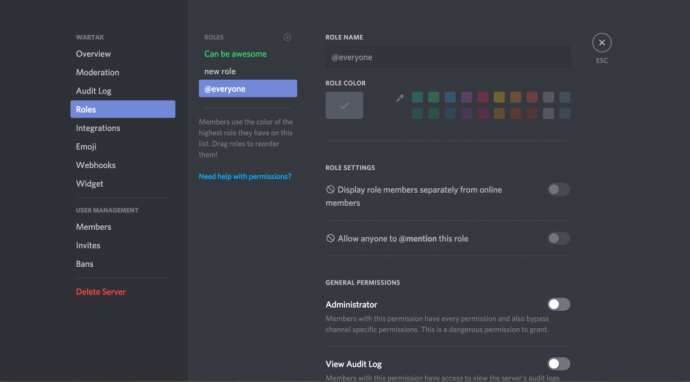How to Create Roles on Discord – Add & Delete Roles On Discord
Discord is the most popular voice and text chat tool among online gamers these days. It's simple to use, very customizable and includes several handy chat features.
These features include the ability to assign and manage roles for chat service users.
How to make Discord Roles
A role is a predefined set of consents with a name in Discord. There is, for example, a default role named "@everyone" that grants a wide variety of fundamental rights such as conversing on the server and reading messages.
A server administrator could add the ability to silence or ban other users by creating a role named "Moderator." Users can be assigned multiple functions; for example, someone with both the @everyone and Moderator roles would have all of the powers of @everyone as well as the powers of a Moderator.
How to Create Roles on Discord
Discord Permissions
On Discord, there are 29 permissions classified into General, Text, and Voice permissions. To properly allocate responsibilities, you must first understand what each one accomplishes. For your convenience, a list of each permission is provided below.
General Permissions
Administrator – The Administrator permission allows access to all of the server's permissions. Granting this permission can be risky because it offers the user a lot of power.
View Audit Log — This access allows the user to read the audit logs on the server.
Manage Server — This access allows the user to alter the server's name or relocate it to a new area.
Manage Roles – This permission enables the user to create new roles and edit existing functions without the manage roles license enabled.
Manage Channels — This access grants the user the ability to create, edit, and delete channels on the server.
Kick Members – This permission grants the user the ability to kick members from the server.
Ban Users — This privilege grants the user the ability to ban members from the service.
Create Instant Invite - with this ability, and the user can invite other users to the server.
Modify Nickname – This permission grants the user the ability to change their nickname.
Manage Nicknames – This capability allows the user to change other users' nicknames.
Read Text & See Voice Channels — This access allows the user to read the message channels.
Manage Emojis — This privilege grants the user access to the server's emoji management.
Manage Webhooks — This permission grants the user the ability to create, amend, and delete webhooks.
Text Permissions
Send TTS Messages — This permission grants the user the ability to send text-to-speech messages.
Manage Messages - with this permission; the user can remove or pin messages from other users.
Embed Links — This permission enables the user to insert hyperlinks into the chat.
Send Messages — This permission enables the user to send text chat messages.
Attach Files — This ability enables the user to attach files to chat conversations.
Read Message History — This capability allows the user to scroll back in time and view earlier communications.
Mention Everyone - this permission enables the user to send push notifications to the channel's members.
Use External Emojis — This permission allows users to access emoji from other servers.
Add Reactions — This permission grants the user the ability to add new reactions to a message.
Voice Permissions
Connect — This permission enables the user to connect to (i.e., hear) the voice channel.
Speak — This permission enables the user to communicate via the voice channel.
Mute Members - with this privilege, the user can disable another member's ability to speak.
Deafen Members – using this privilege; the user can disable another user's ability to hear on the channel.
Shift Members — This permission grants the user the ability to move other members from one channel to another.
Usage Voice Activity – this permission enables the user to communicate without the use of Push-to-Talk.
Priority Speaker - this permission enables the user to lower the volume of other users when they are speaking, making their voice louder on the channel.

How to Make Roles on Discord
The key to effectively managing users on a Discord server is to configure your responsibilities properly. It's a good idea to have the primary roles set up before inviting people to the server. Once you're up and performing, you can always return and add new functions or reconfigure current ones.
1. Log into Discord and connect to your server.

2. Click "Server Settings" after selecting the small dropdown arrow to the right of the server name.

3. In the left pane, select "Roles." There should be a single role called @everyone visible.

4. To add a role, click the "+" icon at the top of the center pane.

5. Give the position a descriptive name and a color (colors help clarify and tell users about each other's duties).

6. Examine all 32 permissions and toggle on only the ones you want to be linked with that role.

At the bottom, click "Save Changes." If you fail to save your changes, a dialog box will display to remind you that you must do so before proceeding.
Repeat for each new role you'd like to create.
By assigning different access levels to distinct roles, you may construct a trust hierarchy. You can give lower-level positions to newcomers and higher-level jobs with additional permissions to people you know well.
How to Create roles on Discord
You must assign roles to users in your chat after establishing them for your server.
1. From the right-hand pane, select the user to whom you wish to assign a role.
2. Select the role from the menu by clicking the small "+" beside the username.
Repetition is required for each user on your server.
You may also rapidly create roles by right-clicking the user, selecting Roles, and selecting the part (s) you want to add from the pop-up menu. Remember that you can assign as many roles to each user as you wish.
How to Assign Discord Roles on Mobile
To create a brand new role and perform it on the go, use the Discord app on your mobile device. The instructions are simple to set and are comparable to those of the desktop program.
1. Scroll down to "Members" from "Settings."
2. Click on the usernames to whom you want to apply for an existing role.
3. For the role you're assigning, check the box next to each member's name.
How to manage roles on Discord
In Discord, managing roles is comparable to creating them. You can add more roles as needed and change the permissions within each. Depending on how you would want to handle your server, you might be able to get away with just two roles: admin and @everyone.
Others can be added as your community expands. Because roles must be assigned to each user individually, the most efficient use of your time is to place as many of your server's policy decisions as possible in the @everyone role so that users will have the rights that you want them to have by default.
You may have seen the left column on the Roles page, which shows the names of all roles you've established. On the server, usernames will display the color of the highest role granted to a user. Users may quickly identify who the server's moderators, admins, and other administrators are.
How to Delete Roles on Discord
It is unusual to need to delete a role in Discord because you could just not assign it. If your account is becoming clogged with new roles, here's how to delete them.
1. Select "Server Settings" from the small dropdown arrow next to your server.
2. In the left pane, pick "Roles" and then the role you want to eliminate.
3. Scroll down to the "Delete [role name]" button.
4. Click "Okay" to confirm.
FAQs
What are Discord Roles?
These are similar to forum or subreddit ranks. They grant users distinct capabilities within a server or make them distinguish out from other users by changing the color of their name or placing them higher in the sidebar.
In Discord 2022, how do you create roles?
Creating Roles
1. Click the arrow next to your server's name.
2. Navigate to "Server Settings."
3. Select "Roles." After that, the Roles page will appear on the right side of the screen, as illustrated here:...
4. Click the "+" button to add a create role. You can rename this role at any time and even change the color of the role.
I'm an administrator, yet I still can't manage the server. What is going on?
If the server's owner gave you an Admin position but can't make some changes, they didn't enable all permissions under your role. Contact the server's owner and have them confirm that you have the necessary rights for your role.



